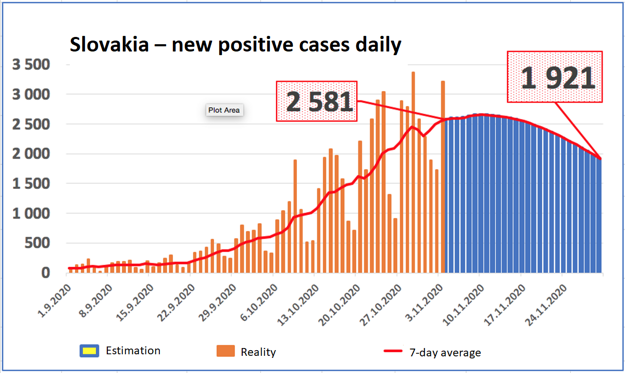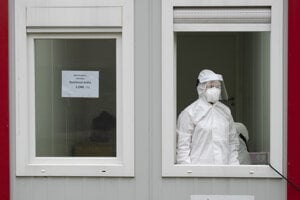More than 7,000 coronavirus patients will need hospital care in November. The worst month is yet to come for hospitals, even though Slovakia is likely at the peak of the second wave of the pandemic and the number of newly infected people has started to decrease slightly.
This figure could decrease from 2,500 infected per day to 1,900 by the beginning of December. The decrease could continue until the end of the year, according to data analysts from the Dáta bez Pátosu (Data without Pathos) project.
The ban on mass events above six people and dining in interiors in restaurants could be lifted at the beginning of January. The state plans to lift anti-epidemic measures when the seven-day median of those infected falls below 500.
“There is both good and bad news,” analyst Ivan Bošňák explained. “Our projection would be confirmed only if stricter rules will be imposed for the riskiest districts, so a lockdown with minimum exceptions.”
 (Source: Data without Pathos)
(Source: Data without Pathos)The movement of people has decreased since October 1, when the mentioned bans were imposed. There are fewer people infected because the state also implemented a partial lockdown on October 15 and the movement of people decreased even more.
The impact of the nationwide testing remains disputable. “If we did not take those two brave steps, pilot and nationwide testing, we would have a result of somewhere above 4,000,” claimed PM Igor Matovič on November 6. He did not explain why the state expected a 1.5 multiple increase in cases if the nationwide testing did not take place.
 Good news for Slovakia, "Czech road" averted for now Read more
Good news for Slovakia, "Czech road" averted for now Read more Scientists admitted that the nationwide testing of people resulting in the subsequent home isolation of thousands who tested positive could help mainly in the most-hit districts. But they ascribe the reversal in the number of new cases mostly to the governmental measures.
“It is possible to assume that the situation has been improving for several days now, especially thanks to a smaller rate of spread of the virus, which is the result of the decreased mobility of citizens,” said mathematician Richard Kollár. Whether the testing with less-accurate antigen tests was effective is “still unknown” he opined.
Čadca is the most-hit district. People with a negative certificate from the nationwide testing can continue going to the shopping centres and restaurant terraces and can visit with others. The rules are the same for those who tested negative in “green” Bratislava.
Kysuce on fire
90 of a total of 10,000 inhabitants tested positive in Kysuce region. Analyst Jakub Tilinger stressed that “Kysuce is on fire”. To compare, Bratislava has 22 positive cases per 10,000 inhabitants under the same measures.
“If the stricter rules do not apply, the numbers of those hospitalised will deviate,” Bošňák warns.






